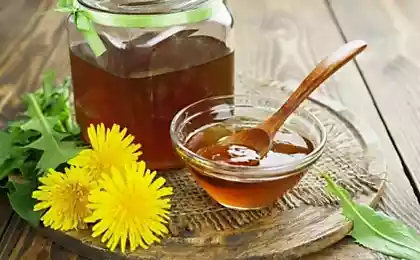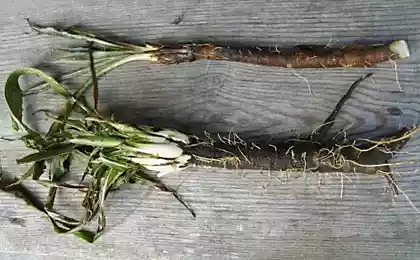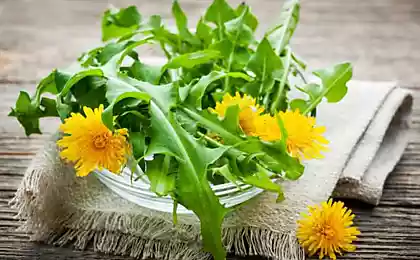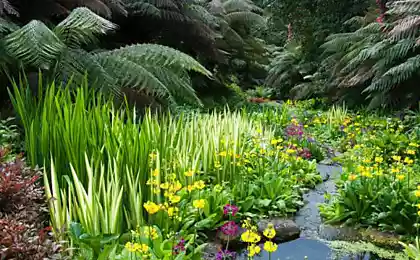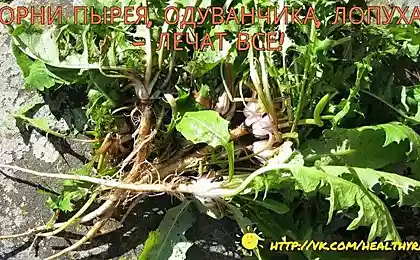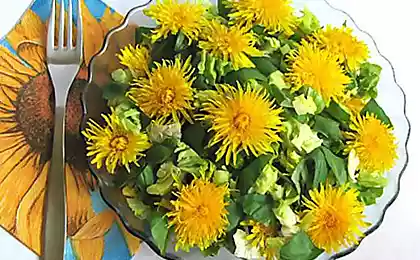504
Amazing benefits of dandelion for your health
Since ancient times, dandelion herb is a common addition to the daily diet. Used in almost all parts of the plant — leaves, flowers and roots. Dandelion has been used not only in cooking but also as medicines for various ailments. Botanists refer it to the family Asteraceae, the genus Taraxacum, and the scientific name of this plant is Taraxacum officinale.
It is also called "the Irish Daisy" (Irish daisy). It is believed that the dandelion has spread from Central Asia. Now it grows in various parts of the world with temperate and subtropical climates. Like the sage, dandelion is rich in vitamin K, but its advantages are not exhausted.
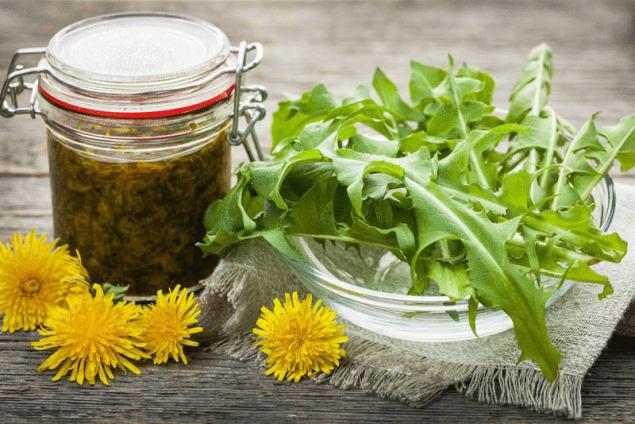
Dandelion has a long and strong taproot, its dark green leaves, long and jagged and grow directly from the soil, like the rays.
Golden yellow flowers appear in late spring on hollow stalks that attract bees filled with sweet nectar. Pedicels are the same as the leaves grow directly from the earth. The Mature plant reaches 45 cm in height. Almost all parts of the plant emit a white "milky juice."
Dandelion root
Spindle-shaped root of the dandelion is strong and fleshy. Outside it is dark brown and the flesh is white and similar in appearance to sweet potatoes (yams, sweet potatoes). It contains bitter "milky juice" in a more concentrated form than the stem and leaves. The roots are generally the basis which will give the plant a chance to proceed to the second year of life. Dandelion roots are harvested in the summer (for medical purposes), or fall (in order to dry, and then crushed to add to the coffee).
The benefits of dandelion for your health
Fresh dandelion greens, flowers and roots contain valuable constituents that are known for their antioxidant properties and abilities to prevent disease and improve health.
Fresh leaves are very low in calories and contain just 45 calories per 100 grams. They are also a good source of dietary fiber (about 9% of the recommended daily consumption of 100 grams). In addition, it has a "milky juice" is a good laxative. These qualities of the plant make it means that help reduce weight and control cholesterol levels in the blood.
Dandelion root, as well as other parts of this plant contain bitter crystalline compound taraxacin, and pressing the resin taraxacin (taraxacerin) is a colorless crystalline compound C8H16O, according to the resource Wordnik. The plant root contains polysaccharide inulin (not to be confused with insulin) and levulin (levulin). Together, these compounds are the basis of the different therapeutic qualities of the dandelion.
Fresh grass dandelion contains 10 161 international units of vitamin A per 100 grams, which is 338% of the recommended daily allowance. Dandelion is one of the richest source of vitamin A among culinary herbs. Vitamin a is an important fat-soluble vitamin and antioxidant that is required for maintaining healthy mucous membranes, skin and vision.
Dandelion leaves also contain numerous health-promoting flavonoids such as beta-carotene, alpha-carotene, lutein, cryptoxanthin and zeaxanthin. Eating natural foods rich in vitamin a and flavonoids (carotenes) helps body protect from lung cancer and oral cavity. Zeaxanthin has setopentime properties, protecting the retina from ultraviolet rays.
The herb dandelion is a good source of minerals such as potassium, calcium, manganese, iron and magnesium. Potassium is an important component of cells and fluids of the body that helps regulate heart rate and blood pressure. Iron is essential for the formation of red blood cells. Manganese is used by the body as a factor-associated antioxidant enzyme called superoxide dismutase.
Dandelion is also rich in many vital vitamins, including folic acid, Riboflavin, pyridoxine, nicotinic acid, vitamins E and C essential to maintain health. Vitamin C — a powerful natural antioxidant. Dandelion greens contains 58% of the recommended daily value of vitamin C.
Dandelion is one of the richest herbal sources of vitamin K, providing about 650% of the recommended allowance. Vitamin K presumably plays a role in the formation of bone mass, keeping them in osteotropic activity. Established role in the treatment of patients with Alzheimer's disease. It reduces damage to neurons of the brain damage.
Selection, storage and processing of dandelion
Sometimes fresh dandelions harvested in the wild. But it is better to give preference to those plants which are collected specifically for medical and culinary purposes.
You should prefer fresh, juicy and soft sheets. Fresh leaves have a better flavor and they are rich in many vital vitamins and antioxidants, beta-carotene, vitamin C and occurring food folate. Store the leaves in a food plastic bags in the drawers of the refrigerator used for storing vegetables.
Fresh leaves and dandelion flowers are used in cooking. Pre-washed greens are blanched in boiling water for a minute and then rapidly cooled by placing in cold water. Blanching allows you to reduce the bitterness.
The use of dandelion in medicine
Almost all parts of the dandelion have found applications both in traditional and in modern medicine. Major contained compounds possess purgative and diuretic properties.
Dandelion is also a good tonic and appetite stimulant agent. This medicinal herb is for patients with dyspepsia when the stomach and intestines do not function normal.
The outer coating of the stems used for burns and allergic skin reactions, for example, on a nettle.
Caution
Because dandelion contains a number of bitterness, it may be consumed only by healthy people without any contraindications to the compounds contained in this plant. Patients who receive treatment of potassium-sparing diuretics, dandelion may cause potassium intoxication. Some sensitive people grass dandelion can cause allergic contact dermatitis.
Nutritional value of dandelion
In parentheses are the percentage of the daily allowance. Nutritional value is based on 100 grams of dandelion greens according to information from the Ministry of agriculture of the USA, shown in the resource Nutrition And You.
General information:
energy value — 45 calories (2%);
carbohydrates — 9,20 gram (7%);
protein — 2,70 gram (5%);
fats — 0.70 grams (3%);
fiber, part of the food — 3.50 grams (9%).
Vitamins:
folic acid (vitamin B9) — 27 micrograms (7%);
nicotinic acid (vitamin B3) — AZN 0.806 milligram (5%);
Pantothenic acid was 0.084 milligrams (1,5%);
pyridoxine (vitamin B6) — 0,251 milligrams (19%);
Riboflavin (vitamin B2) — is 0.260 milligrams (20%);
thiamine (vitamin B1) — 0,190 milligrams (17%);
vitamin A — 10161 international units (IU, IU) — 338%;
vitamin C 35 mg (58%);
vitamin E 3.44 mg (23%);
vitamin K — 778,4 micrograms (649%);
Electrolytes:
sodium — 76 mg (5%);
potassium 397 mg (8%).
Minerals:
calcium 187 mg (19%);
iron — 3,10 milligrams (39%);
magnesium — 36 mg (9%);
manganese — 0,342 milligrams (15%);
phosphorus — 66 mg (9%);
selenium — 0.5 milligrams (1%);
zinc — 0.41 milligrams (4%).
Phytonutrients:
alpha-carotene (α-carotene) — 363 micrograms;
beta-carotene (ß-carotene), which is rich in carrots — 5854 micrograms;
beta-cryptoxanthin (ß-cryptoxanthin) — 121 micrograms;
lutein-zeaxanthin — 13 610 micrograms. published
P. S. And remember, only by changing their consumption - together we change the world! ©
Source: hi-news.ru
It is also called "the Irish Daisy" (Irish daisy). It is believed that the dandelion has spread from Central Asia. Now it grows in various parts of the world with temperate and subtropical climates. Like the sage, dandelion is rich in vitamin K, but its advantages are not exhausted.

Dandelion has a long and strong taproot, its dark green leaves, long and jagged and grow directly from the soil, like the rays.
Golden yellow flowers appear in late spring on hollow stalks that attract bees filled with sweet nectar. Pedicels are the same as the leaves grow directly from the earth. The Mature plant reaches 45 cm in height. Almost all parts of the plant emit a white "milky juice."
Dandelion root
Spindle-shaped root of the dandelion is strong and fleshy. Outside it is dark brown and the flesh is white and similar in appearance to sweet potatoes (yams, sweet potatoes). It contains bitter "milky juice" in a more concentrated form than the stem and leaves. The roots are generally the basis which will give the plant a chance to proceed to the second year of life. Dandelion roots are harvested in the summer (for medical purposes), or fall (in order to dry, and then crushed to add to the coffee).
The benefits of dandelion for your health
Fresh dandelion greens, flowers and roots contain valuable constituents that are known for their antioxidant properties and abilities to prevent disease and improve health.
Fresh leaves are very low in calories and contain just 45 calories per 100 grams. They are also a good source of dietary fiber (about 9% of the recommended daily consumption of 100 grams). In addition, it has a "milky juice" is a good laxative. These qualities of the plant make it means that help reduce weight and control cholesterol levels in the blood.
Dandelion root, as well as other parts of this plant contain bitter crystalline compound taraxacin, and pressing the resin taraxacin (taraxacerin) is a colorless crystalline compound C8H16O, according to the resource Wordnik. The plant root contains polysaccharide inulin (not to be confused with insulin) and levulin (levulin). Together, these compounds are the basis of the different therapeutic qualities of the dandelion.
Fresh grass dandelion contains 10 161 international units of vitamin A per 100 grams, which is 338% of the recommended daily allowance. Dandelion is one of the richest source of vitamin A among culinary herbs. Vitamin a is an important fat-soluble vitamin and antioxidant that is required for maintaining healthy mucous membranes, skin and vision.
Dandelion leaves also contain numerous health-promoting flavonoids such as beta-carotene, alpha-carotene, lutein, cryptoxanthin and zeaxanthin. Eating natural foods rich in vitamin a and flavonoids (carotenes) helps body protect from lung cancer and oral cavity. Zeaxanthin has setopentime properties, protecting the retina from ultraviolet rays.
The herb dandelion is a good source of minerals such as potassium, calcium, manganese, iron and magnesium. Potassium is an important component of cells and fluids of the body that helps regulate heart rate and blood pressure. Iron is essential for the formation of red blood cells. Manganese is used by the body as a factor-associated antioxidant enzyme called superoxide dismutase.
Dandelion is also rich in many vital vitamins, including folic acid, Riboflavin, pyridoxine, nicotinic acid, vitamins E and C essential to maintain health. Vitamin C — a powerful natural antioxidant. Dandelion greens contains 58% of the recommended daily value of vitamin C.
Dandelion is one of the richest herbal sources of vitamin K, providing about 650% of the recommended allowance. Vitamin K presumably plays a role in the formation of bone mass, keeping them in osteotropic activity. Established role in the treatment of patients with Alzheimer's disease. It reduces damage to neurons of the brain damage.
Selection, storage and processing of dandelion
Sometimes fresh dandelions harvested in the wild. But it is better to give preference to those plants which are collected specifically for medical and culinary purposes.
You should prefer fresh, juicy and soft sheets. Fresh leaves have a better flavor and they are rich in many vital vitamins and antioxidants, beta-carotene, vitamin C and occurring food folate. Store the leaves in a food plastic bags in the drawers of the refrigerator used for storing vegetables.
Fresh leaves and dandelion flowers are used in cooking. Pre-washed greens are blanched in boiling water for a minute and then rapidly cooled by placing in cold water. Blanching allows you to reduce the bitterness.
The use of dandelion in medicine
Almost all parts of the dandelion have found applications both in traditional and in modern medicine. Major contained compounds possess purgative and diuretic properties.
Dandelion is also a good tonic and appetite stimulant agent. This medicinal herb is for patients with dyspepsia when the stomach and intestines do not function normal.
The outer coating of the stems used for burns and allergic skin reactions, for example, on a nettle.
Caution
Because dandelion contains a number of bitterness, it may be consumed only by healthy people without any contraindications to the compounds contained in this plant. Patients who receive treatment of potassium-sparing diuretics, dandelion may cause potassium intoxication. Some sensitive people grass dandelion can cause allergic contact dermatitis.
Nutritional value of dandelion
In parentheses are the percentage of the daily allowance. Nutritional value is based on 100 grams of dandelion greens according to information from the Ministry of agriculture of the USA, shown in the resource Nutrition And You.
General information:
energy value — 45 calories (2%);
carbohydrates — 9,20 gram (7%);
protein — 2,70 gram (5%);
fats — 0.70 grams (3%);
fiber, part of the food — 3.50 grams (9%).
Vitamins:
folic acid (vitamin B9) — 27 micrograms (7%);
nicotinic acid (vitamin B3) — AZN 0.806 milligram (5%);
Pantothenic acid was 0.084 milligrams (1,5%);
pyridoxine (vitamin B6) — 0,251 milligrams (19%);
Riboflavin (vitamin B2) — is 0.260 milligrams (20%);
thiamine (vitamin B1) — 0,190 milligrams (17%);
vitamin A — 10161 international units (IU, IU) — 338%;
vitamin C 35 mg (58%);
vitamin E 3.44 mg (23%);
vitamin K — 778,4 micrograms (649%);
Electrolytes:
sodium — 76 mg (5%);
potassium 397 mg (8%).
Minerals:
calcium 187 mg (19%);
iron — 3,10 milligrams (39%);
magnesium — 36 mg (9%);
manganese — 0,342 milligrams (15%);
phosphorus — 66 mg (9%);
selenium — 0.5 milligrams (1%);
zinc — 0.41 milligrams (4%).
Phytonutrients:
alpha-carotene (α-carotene) — 363 micrograms;
beta-carotene (ß-carotene), which is rich in carrots — 5854 micrograms;
beta-cryptoxanthin (ß-cryptoxanthin) — 121 micrograms;
lutein-zeaxanthin — 13 610 micrograms. published
P. S. And remember, only by changing their consumption - together we change the world! ©
Source: hi-news.ru


